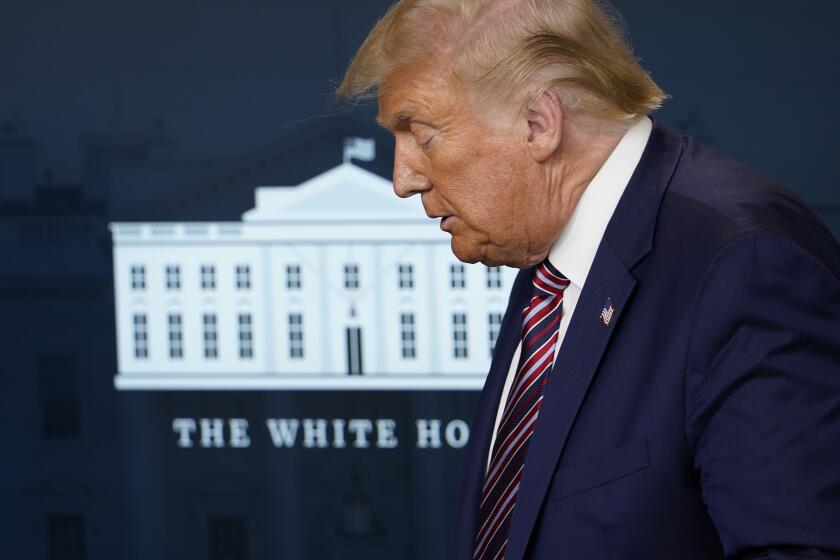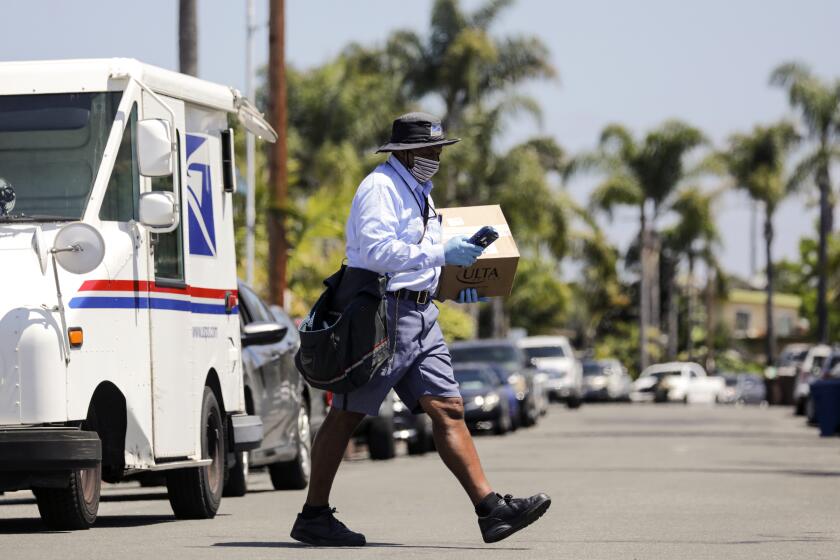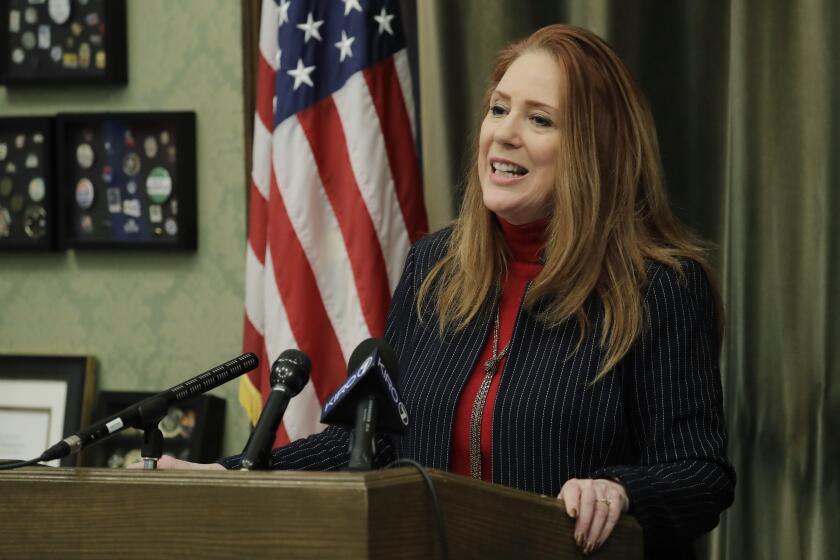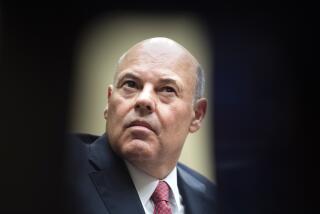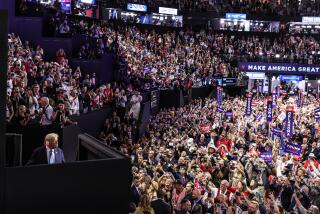‘Chaos and confusion’: What is going on at the post office and how could it affect mail voting?
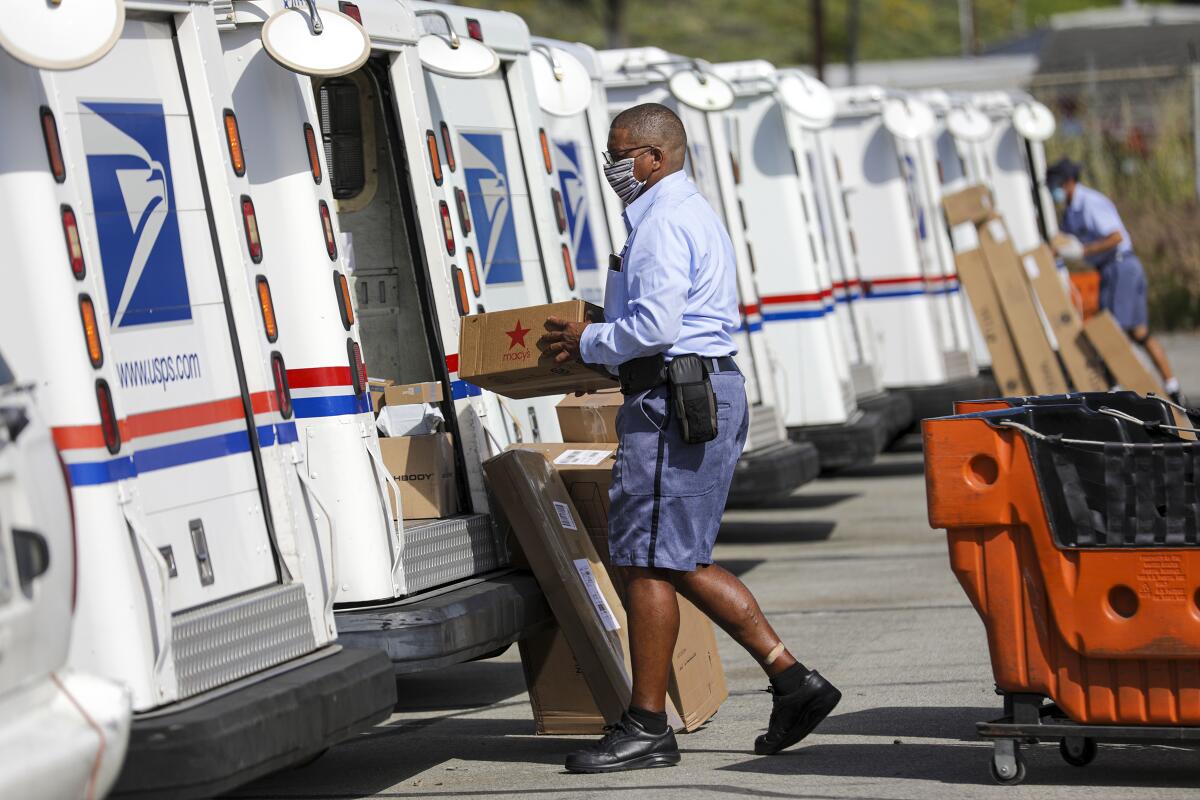
The United States Postal Service has possibly never been more important, or more embattled.
The 245-year-old organization has faced years of derision from President Trump. And as the election nears with his prospects uncertain, Trump has intensified his unfounded claims against voting by mail and his institutional attacks on the government service charged with getting ballots to voters and back.
Election officials expect to send a record number of mail ballots to voters this fall, as states seek to avoid the spread of the deadly coronavirus at in-person polling places. But the more prominent role of the postal service, formed by the Second Continental Congress at the start of the Revolutionary War, comes as it weathers more serious challenges than snow, rain, heat or gloom of night.
The pandemic has led to staff shortages and a steep decline in letter mail, the most profitable part of the service, worsening its precarious financial situation. And now a close Trump ally and GOP donor put in charge of the agency has introduced unpopular policies that have delayed mail and raised concerns that voters won’t get their ballots on time.
Members of Congress in both parties have called on the organization to reverse the changes, and Democrats have asked for an investigation into the motives and fallout of the policies. The moves have been portrayed as cost cutting at a struggling institution, but critics say the president and his allies are attempting to undermine faith in the postal service — which 91% of Americans view favorably — to suppress the November vote and, ultimately, to move one step closer to privatizing the organization.
“There are those in power doing their darnedest to discourage people from voting — by closing polling locations, and targeting minorities and students with restrictive ID laws, and attacking our voting rights with surgical precision, even undermining the postal service in the run-up to an election that is going to be dependent on mailed-in ballots so people don’t get sick,” President Obama said last month during his eulogy at Rep. John Lewis’ funeral.
Trump, who has spent the last several months claiming without evidence that mail voting will lead to widespread fraud in the general election, has also tried to sow doubt in the postal service’s ability to securely deliver mail ballots.
“I don’t think the post office is prepared for a thing like this,” Trump said Aug. 3. Two days later, he said he wasn’t sure the postal service had “enough time” to handle an influx of election mail.
And on Thursday, Trump, who has said expanded voting could hurt Republicans’ election chances, explained his opposition to Democrats’ proposed funding for the postal service and mail-in balloting:
“Now, they need that money in order to have the post office work, so it can take all of these millions and millions of ballots.... But if they don’t get those two items that means you can’t have universal mail-in voting because they’re not equipped to have it.”
President Trump says he opposes additional funding for the Postal Service that Democrats say it needs to process a surge in mail-in ballots.
Here’s where things stand fewer than three months before the election.
A Trump ally in charge at the postal service
This May the USPS Board of Governors appointed by the president unanimously installed major Republican donor Louis DeJoy as the new postmaster general. Unlike recent postmasters, the former logistics executive had no prior postal service experience. (His predecessor, Megan Brennan, started her 33-year career at the agency as a mail carrier.) Initially, criticism of his appointment centered on his close ties to the Trump administration — DeJoy was in charge of fundraising for the 2020 Republican National Convention — then he started making changes.
Within weeks of taking charge of the organization that employs 630,000 workers, DeJoy implemented an “operational pivot” aimed at cutting overtime and late and extra trips, according to a memo first reported by the Washington Post. “One aspect of these changes that may be difficult for employees is that — temporarily — we may see mail left behind or mail on the workroom floor … which is not typical,” the memo reads.
The result has been widespread reports of delayed mail, including prescription drugs for veterans. The changes “can’t do anything but slow down and degrade mail service,” Mark Dimondstein, the president of the American Postal Workers Union, said in an interview. “All the reports we’re getting from both the workers and customers is that it’s already doing that,” he added.
Members of Congress from both parties have raised concerns about post office closures and service reductions. House Speaker Nancy Pelosi and Senate Minority Leader Charles E. Schumer wrote to DeJoy on Aug. 6, after a tense meeting to negotiate stimulus funding for the USPS, to ask him to undo his new policies. The Democratic leaders said DeJoy confirmed changes to overtime, extra trips, delivery policies and a reduction in processing equipment.
“While it is true that the Postal Service has and continues to face financial challenges, enacting these policies as cost-cutting or efficiency measures as the COVID-19 public health emergency continues is counterproductive and unacceptable,” the letter reads.
The U.S. Postal Service has faced many challenges since its inception. Coronavirus puts new stress on the institution, currently in Trump’s crosshairs.
DeJoy has drastically restructured the top leadership of the post office and frozen hiring. He has denied acting at the direction of the president or his administration and claimed “despite any assertions to the contrary, we are not slowing down Election Mail or any other mail.”
Ethics watchdogs have also questioned DeJoy’s financial investments. DeJoy divested his stock in UPS but retained a stake of at least $30 million in his former company XPO Logistics, which contracts with the agency he now runs. In June, he divested his Amazon shares, but bought stock options the same day, according to CNN.
“Postmaster General Louis DeJoy’s investments in @USPS competitors were already deeply problematic,” Sen. Elizabeth Warren wrote in a tweet on Thursday. “But his purchase of @amazon stock options after his appointment is inexcusable. The @OIGUSPS must investigate this corruption.”
What do these changes mean for the election?
The delays at the postal service have led to widespread concerns that critical election mail will arrive late, disenfranchising voters.
“What we will have is chaos and confusion,” said Wendy Fields, the executive director of the Democracy Initiative, a voting rights group. Fields said the risk is that voters won’t get their ballots on time, and there won’t be enough open polling places to support voters.
Democratic leaders and groups like Fields’ say the president and his allies are attempting to suppress the vote by upending faith in the service’s ability to deliver mail heading into an election where officials expect to see a record number of mail ballots.
“To decide you’re going to institute ‘organizational efficiencies’ in the middle of that context is not a coincidence,” said Rep. Gerry Connolly (D-Va.), who chairs a House Oversight subcommittee with jurisdiction over the postal service. “This is an attempt at massive voter suppression, pure and simple.”
Congressional Democrats have asked the USPS inspector general to investigate DeJoy’s changes and the rationale behind them. DeJoy is scheduled to appear before the House Oversight Committee on Sept. 17.
Is the postal service struggling financially?
Yes. But for the vast majority of the service’s existence, it wasn’t meant to fund its operation from its own revenue. The Post Office was a general government department, funded by taxpayers, much like the Education Department and the military. That changed in 1971, when Congress passed the Postal Reorganization Act, turning it into an independent, self-sustaining agency.
Part of the service’s financial issues is that Congress passed a law in 2006 requiring the agency to prefund its retiree health benefits more than 50 years into the future over the course of a decade. (USPS stopped making those payments — of about $5.5 billion — in 2012.)
And first class mail has dropped from 104 billion pieces a year in 2001 to 55 billion in 2019. The pandemic has led to an uptick in packages, but a further drop in letter mail that cost the agency $2.2 billion in 3 months, it said last week.
In April, the board of governors asked Congress for $75 billion, after the March stimulus bill included only a $10- billion Treasury loan. House Democrats passed legislation in May that included $25 billion; the Senate has offered zero.
Trump has said the postal service struggles because it doesn’t charge enough to e-commerce companies. He has railed against Amazon and its founder, Jeff Bezos, who also owns the Washington Post. In April, he said if the Post Office doesn’t at least quadruple prices on companies like Amazon, he wouldn’t sign any bills that include more funding.
Analysts say such a price increase would be disastrous. “For the postal service to simply quadruple or quintuple prices would be madness, their volume would just plummet,” said Kevin Kosar, a former USPS analyst for the Congressional Research Service and current vice president of research partnerships at the R Street Institute, a limited government group.
Is the post office threatening to triple mail ballot rates?
It’s complicated.
During an Aug. 11 Senate floor speech, Schumer accused the Trump administration of attempting to dramatically increase the cost to states to send mail ballots in a further attempt to derail the election.
“Now, topping the cake, the postal service has informed some states they may need to pay a first class rate to deliver ballots rather than the normal rate, nearly tripling the cost at a time when people will have to vote by mail in record numbers because they can’t or won’t go vote in person,” Schumer said.
The service has denied plans to change the cost of sending ballots. “There are currently no pending changes to the rates and classes of mail impacting ballots,” spokeswoman Martha Johnson said in a statement. But she added that the service had for years “strongly recommended that election officials use First-Class Mail when mailing ballots.”
But there do appear to be enforcement changes that would affect delivery times of ballots.
Election officials typically use marketing mail (or nonprofit bulk) to send out ballots, which is cheaper than using first class mail. The delivery timelines, however, are different: Marketing mail takes three to 10 days, while first class mail is delivered in two to five days. The postal service has traditionally treated election mail with priority, even if it’s not sent first class.
But USPS General Counsel Thomas Marshall implied in letters to election officials that marketing mail delivery standards would be enforced for election mail.
“Using Marketing Mail will result in slower delivery times and will increase the risk that voters will not receive their ballots in time to return them by mail,” Marshall wrote in language later repeated in Johnson’s statement.
President Trump claims mail voting leads to mass fraud. But the go-to expert who defends the practice is an election official from his own party.
When she received the letter, Washington Secretary of State Kim Wyman was concerned her office would need to make significant changes. Her state has administered all-mail elections for years.
After meeting with postal service representatives, Wyman said she would probably advise counties to send ballots first class closer to election day. The state allows voters to request ballots up to eight days before the election.
“They were just reminding us,” she said, “which I took as an indication that ... delivery may be getting slower, potentially, and if that happens, make your plans accordingly.”
More to Read
Get the L.A. Times Politics newsletter
Deeply reported insights into legislation, politics and policy from Sacramento, Washington and beyond. In your inbox three times per week.
You may occasionally receive promotional content from the Los Angeles Times.
